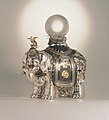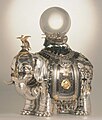File:Khalili Collection Japanese Meiji Art M072.jpg

Original file (2,500 × 2,742 pixels, file size: 1.18 MB, MIME type: image/jpeg)
| This is a file from the Wikimedia Commons. Information from its description page there is shown below. Commons is a freely licensed media file repository. You can help. |
Contents
Summary
Object
| Incense Burner (Koro)
|
|||||||||||||||||||||
|---|---|---|---|---|---|---|---|---|---|---|---|---|---|---|---|---|---|---|---|---|---|
| Title |
Incense Burner (Koro) |
||||||||||||||||||||
| Object type |
censer |
||||||||||||||||||||
| Description |
English: A silver koro modelled as an elaborately caparisoned elephant with a richly embellished harness comprising a bejewelled saddle-cloth bearing shishi masks and minogame, supporting a coiled dragon standing on swirling clouds holding a large rock-crystal ball. The creature's headdress in the form of a stepped base upon which stands a gold ho-o bird with its wings spread. The whole carved and applied in shakudo, shibuichi, gold, silver, and a shakudo-copper mokume alloy. Details of the caparison are inlaid in rock crystal, malachite, coral, tiger's-eye, agate, and nephrite. It is interesting to consider the symbolism in this object, for it gives an insight into a spiritual aspect of the Japanese character at the time of the Meiji Restoraion as well as exemplifying Japanese aspirations abroad. The white elephant is an animal of great significance in Buddhism. It is the mount of the Bodhisattva Fugen, while his brother bodhisattva rides a lion-like beast called a shishi. They are the bodhisattvas of wisdom and are said to have been born during the lifetime of the historical Buddha. The elephant was one of the animals present at the death and final enlightenment of the Buddha. The elephant has a saddle in the form of a lotus, which, being symbolic of rebirth, is the throne for all holy beings in Buddhism. On the throne is a cloud upon which rides a coiled dragon, a messenger of Buddhism representing almighty power. The cloud signifies that the dragon exists in a realm beyond the heavens. The dragon supports a crystal ball, which in popular legend represents a jewel that controls the tides. In this case the crystal, by its clarity and brightness, represents the essence of Buddha's teaching, and it is thus a replacement for the bodhisattva who usually rides the elephant. The saddle-cloth bears faces of the shishi, which guards holy beings and whose roar expresses the power of Buddha's law. Below the shishi are, on one side, the minogame, turtles trailing waterweed behind them, and on the other a crane, both symbolizing longevity and associated with Chinese immortals. The stylized scrolling on the caparison can carry either lotus flowers or the flowers of the Bo-tree, under which the Buddha became enlightened. The phoenix forming a crown on the head of the elephant is the most auspicious of creatures, flying through the realm of Buddhism and representing the joy of Buddha's law. Stylized magic coats from among the auspicious objects associated with the Seven Deities of Fortune hang from the caparison and alternate with bells along the bottom edge of the saddle-cloth. The ringing of bells is to dispel illusion, and represents the spiritual awakening of Buddhism. Thus, the elephant is a messenger of Buddhist wisdom. |
||||||||||||||||||||
| Date |
circa |
||||||||||||||||||||
| Collection |
institution QS:P195,Q63160499 |
||||||||||||||||||||
| Accession number | |||||||||||||||||||||
| Place of creation |
Japan |
||||||||||||||||||||
| References |
https://www.khalilicollections.org/collections/japanese-art-of-the-meiji-period/khalili-collections-japanese-art-of-the-meiji-period-incense-burner-m72/ (English) |
||||||||||||||||||||
Photograph
| Author | Khalili Collections | ||
| Permission (Reusing this file) |
|
||
| Other versions |
|
Licensing
- You are free:
- to share – to copy, distribute and transmit the work
- to remix – to adapt the work
- Under the following conditions:
- attribution – You must give appropriate credit, provide a link to the license, and indicate if changes were made. You may do so in any reasonable manner, but not in any way that suggests the licensor endorses you or your use.
- share alike – If you remix, transform, or build upon the material, you must distribute your contributions under the same or compatible license as the original.
Captions
Items portrayed in this file
depicts
File history
Click on a date/time to view the file as it appeared at that time.
| Date/Time | Thumbnail | Dimensions | User | Comment | |
|---|---|---|---|---|---|
| current | 16:37, 12 November 2020 |  | 2,500 × 2,742 (1.18 MB) | MartinPoulter | Opened and saved in IrfanView to fix colours |
| 15:38, 12 November 2020 |  | 2,500 × 2,742 (974 KB) | MartinPoulter | pattypan 20.04 |
File usage
Metadata
This file contains additional information, probably added from the digital camera or scanner used to create or digitize it.
If the file has been modified from its original state, some details may not fully reflect the modified file.
| Copyright holder |
|
|---|---|
| Width | 2,500 px |
| Height | 2,742 px |
| Compression scheme | Uncompressed |
| Pixel composition | Separated (Probably CMYK) |
| Orientation | Normal |
| Number of components | 4 |
| Horizontal resolution | 350 dpi |
| Vertical resolution | 350 dpi |
| Data arrangement | chunky format |
| Software used | Adobe Photoshop CS6 (Macintosh) |
| File change date and time | 16:04, 11 December 2018 |
| Color space | Uncalibrated |
| Unique ID of original document | adobe:docid:photoshop:ff4e8bc5-b625-11d8-9722-da647cc13c31 |
| Date and time of digitizing | 13:00, 2 June 2004 |
| Date metadata was last modified | 16:04, 11 December 2018 |
| Copyright status | Copyrighted |




